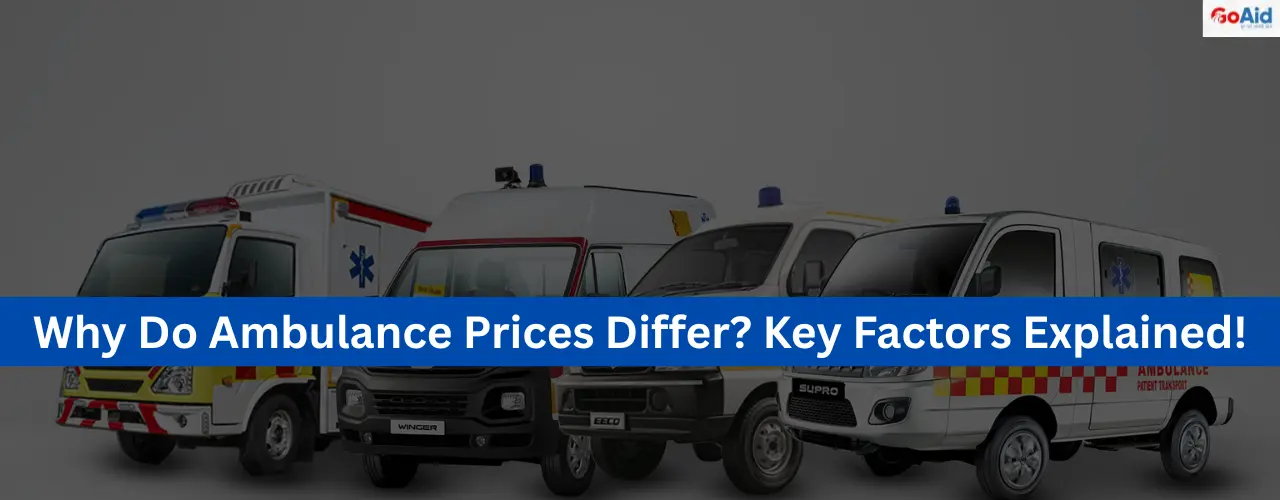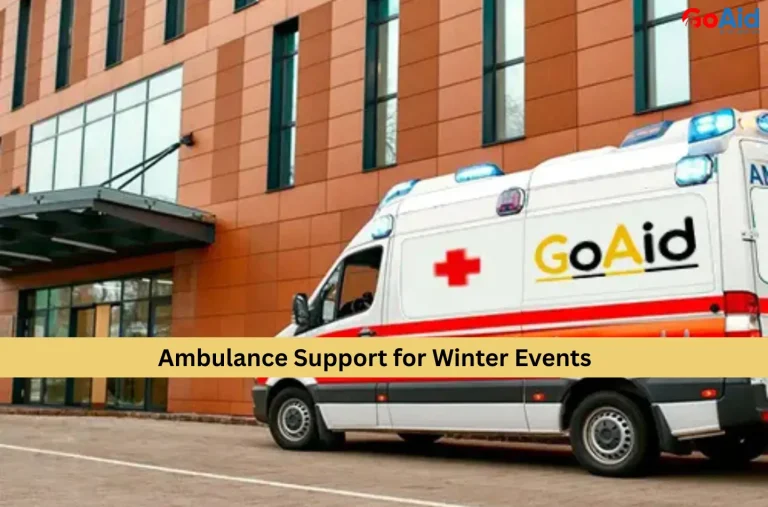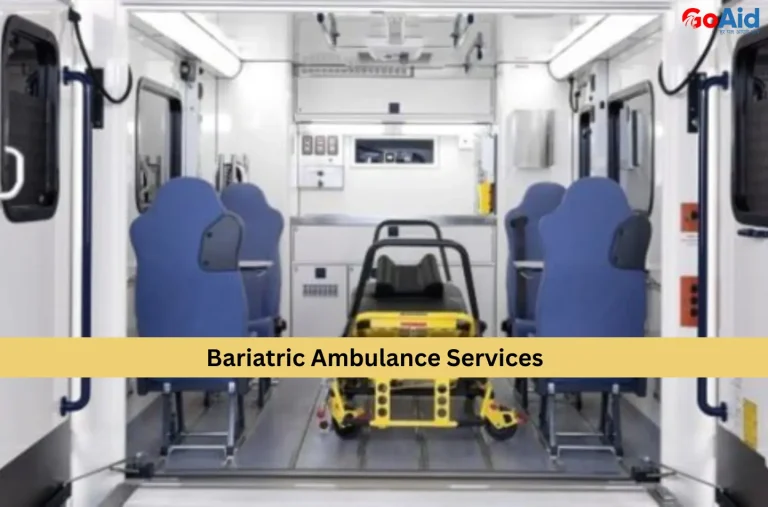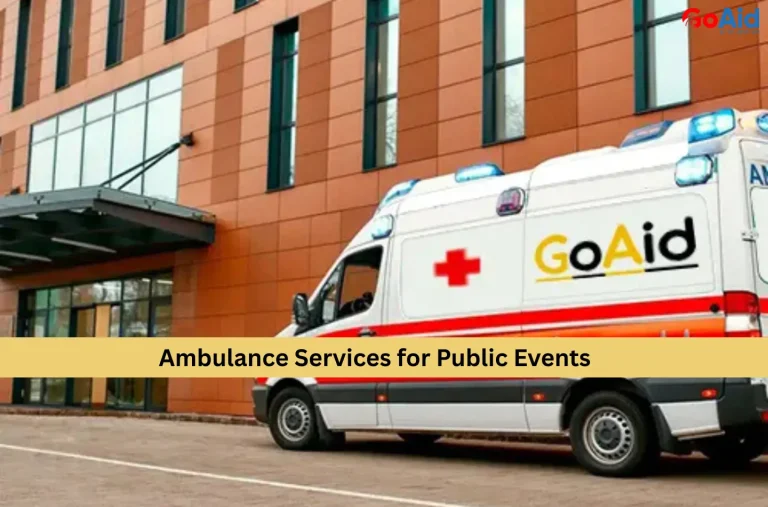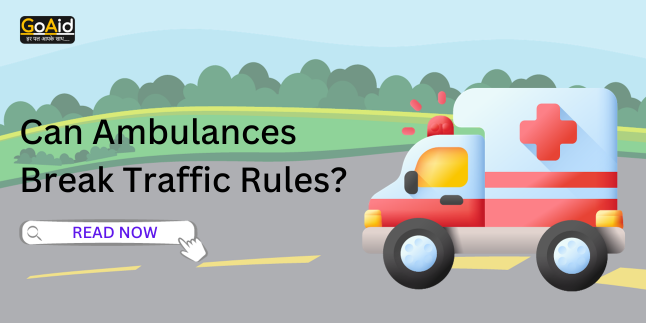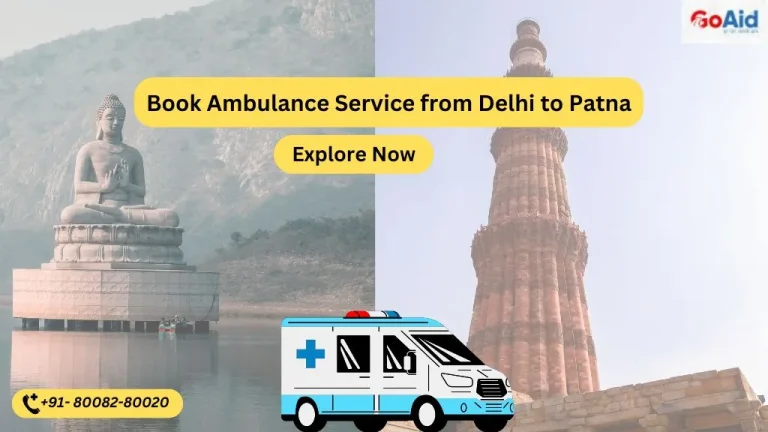Have you ever wondered why the cost of an ambulance isn’t the same every time? In India, ambulance prices can vary a lot depending on several key factors, like the type of ambulance, the distance covered, and even the service provider. Many people get confused or surprised by these price differences during emergencies.
ThatŌĆÖs why understanding the ambulance cost factors is so important. In this blog, weŌĆÖve covered everything about ambulance prices in India, what affects them, and how to plan better in medical situations. If youŌĆÖre curious to know the real reasons behind varying ambulance prices, read this blog till the end.
What are the General Ambulance Prices in India? ŌĆō Category-wise
Ambulance prices in India differ based on the service type, medical equipment provided, patient condition, and distance. Here’s a category-wise breakdown:
1. BLS / Normal Ambulance
Basic Life Support (BLS) or normal ambulances are designed for non-critical patient transport. They include essential equipment like oxygen cylinders, stretchers, and first aid kits. Ideal for stable patients who donŌĆÖt require advanced care during travel. These ambulances are commonly used for hospital transfers or discharge.
The cost of BLS/Normal ambulance service: Ōé╣500 ŌĆō Ōé╣2,000
2. ALS Ambulance
Advanced Life Support (ALS) ambulances cater to critically ill patients. They come with equipment like ECG monitors, defibrillators, ventilators, and are manned by trained paramedics. These ambulances are necessary for patients needing continuous medical supervision and life-saving interventions en route to a medical facility.
The cost of ALS ambulance service: Ōé╣2,500 ŌĆō Ōé╣5,000
Also Read: Difference between BLS Ambulance and ALS Ambulance
3. ICU Ambulance / Cardiac Ambulance
ICU or Cardiac ambulances serve patients in extremely critical conditions, such as cardiac arrest or coma. These ambulances replicate an Intensive Care Unit setup with advanced ventilators, infusion pumps, suction machines, and ICU staff. They ensure round-the-clock critical care during transit.
The cost of ICU/Cardiac ambulance service: Ōé╣5,000 ŌĆō Ōé╣10,000
4. Oxygen Ambulance
Oxygen ambulances are equipped with oxygen cylinders and masks to provide continuous respiratory support. They are suitable for patients suffering from breathlessness, asthma, or post-surgical weakness. These ambulances are often used during transfers from homes to hospitals and vice versa.
The cost of the Oxygen ambulance service: Ōé╣1,500 ŌĆō Ōé╣3,000
5. Air Ambulance
Air ambulances are aircraft or helicopters equipped with ICU-grade medical facilities. Used for emergency long-distance transfers, they can reach remote areas or distant cities quickly. Staffed with doctors and paramedics, air ambulances are life-saving during organ transplants, critical illness, or accidents.
The cost of Air ambulance service: Ōé╣1.5 lakh ŌĆō Ōé╣6 lakh
6. Train Ambulance
Train ambulances are used for intercity patient transfers via Indian Railways. These setups convert train compartments into temporary ICUs with medical personnel, oxygen, monitors, and beds. They offer a more economical solution for long-distance critical transfers compared to air ambulances.
The cost of Train ambulance service: Ōé╣20,000 ŌĆō Ōé╣80,000
7. Neonatal Ambulance
Neonatal ambulances are specialized units equipped with incubators, ventilators, and neonatal ICU tools for transporting newborns and premature babies. They are handled by trained neonatal care teams, ensuring safe and sterile transfers to pediatric facilities or neonatal intensive care units (NICUs).
The cost of Neonatal ambulance service: Ōé╣4,000 ŌĆō Ōé╣8,000
8. Surgery Ambulance
Surgical ambulances are tailored for patients who are pre- or post-surgery. These vehicles offer medical support systems to maintain vitals, prevent complications, and ensure stable transport. The staff onboard is trained to handle emergency medical needs during the journey.
The cost of the Surgery ambulance service: Ōé╣4,000 ŌĆō Ōé╣7,000
9. Dead Body Ambulance / Mortuary Van
Dead body ambulances are used to transport deceased persons from hospitals to homes or crematoriums. These vans are hygienic, respectful in design, and suited for short to medium distances without a cooling system.
The cost of Dead Body/Mortuary van service: Ōé╣1,000 ŌĆō Ōé╣3,000
10. Dead Body Freezer Box Ambulance
These ambulances are equipped with a freezer box to prevent body decomposition during long-distance transport. Ideal for intercity or overnight travel, they help preserve the deceased with dignity and respect, especially in high temperatures.
The cost of the Dead Body Freezer Box ambulance service: Ōé╣2,000 ŌĆō Ōé╣5,000
Why Do Ambulance Prices Differ from One Type to Another?
Ambulance prices vary based on the medical needs, equipment involved, and the urgency of the situation. Each type serves a different level of care and complexity.
1. Medical Equipment Used
ICU and ALS ambulances are equipped with ventilators, ECGs, and advanced life-support machines, while BLS or normal ambulances carry basic equipment. Higher-grade medical tools increase operational costs and service pricing.
2. Level of Medical Staff
Ambulances like ICU or neonatal ones include doctors, nurses, or paramedics. The involvement of specialized staff adds to the cost compared to normal ambulances that only need a driver and a basic assistant.
3. PatientŌĆÖs Condition
Critical patients require continuous care, which demands advanced ambulances and round-the-clock monitoring. The complexity of care and risk level directly influence pricing compared to stable patient transfers.
4. Distance & Duration of Travel
Longer distances or intercity transports consume more fuel and time, and may require backup medical support or oxygen refills. These factors raise the overall cost, especially for oxygen or train ambulances.
5. Ambulance Size & Type
Larger ambulances, such as stretcher or surgical units, offer more space and customized interiors, which increases maintenance and service costs compared to compact wheelchair vans or mortuary vehicles.
6. Additional Support Services
Add-ons like freezer boxes, ventilator care, or mobile ICU services demand extra setup, backup power, and ongoing maintenance, leading to varied price ranges across ambulance types.
7. Mode of Transport
Air and train ambulances involve higher operational complexity, permissions, and logistics. Air ambulances, in particular, are expensive due to aviation costs, making them the costliest ambulance type.
Why Do Ambulance Prices Differ from One Provider to Another?
Ambulance service charges can also differ based on the providerŌĆÖs quality, facilities, and operational standards. Each provider runs its services under different policies and infrastructure.
1. Fleet Quality and Maintenance
Providers with new, well-maintained, and GPS-enabled ambulances may charge more than those operating outdated or poorly-equipped vehicles. Modern ambulances also ensure better safety and comfort.
2. Response Time & Availability
Services offering guaranteed 10-minute arrivals or 24/7 coverage often charge higher due to better technology and staffing. Rapid response capability adds value and cost to the service.
3. Service Network Size
Larger ambulance providers with nationwide presence and dispatch systems like GoAid may have dynamic pricing due to scalability, while local vendors may offer flat or lower rates for limited areas.
4. Medical Staff Expertise
Ambulance companies with certified doctors, trained paramedics, and NICU staff onboard charge more than basic ambulance providers that may rely on attendants with minimal training.
5. Ambulance Type Customization
Some providers offer tailored servicesŌĆöpediatric care, bariatric stretchers, or isolation chambers. These customizations lead to higher prices due to extra investment in medical-grade configurations.
6. Technology Integration
GPS tracking, real-time monitoring, and dispatch systems (like GoAidŌĆÖs tech-enabled platform) increase efficiency but also add to the service cost due to software and communication systems.
7. Brand Trust & Regulations
Reputed or government-approved providers follow higher regulatory standards, medical compliance, and insurance partnerships. Such providers might charge slightly more but offer trustworthy and secure service.
Key Factors That Affect the Prices of Ambulances in India
Ambulance pricing depends on several factors, including service type, medical needs, distance, and provider. Understanding these factors helps you make informed decisions during emergencies.
1. Type of Ambulance
The type of ambulance, whether BLS, ALS, ICU, or air ambulance, significantly impacts pricing. Higher-level services like the ICU require advanced medical equipment and skilled personnel, thus raising costs.
2. Medical Equipment
Ambulances equipped with specialized equipment, such as ventilators, defibrillators, or oxygen, have higher operational costs. These medical devices ensure critical care but add to the overall service price.
3. Level of Medical Personnel
ICU ambulances staffed with doctors, nurses, or paramedics cost more due to the expertise required. Basic ambulances, with only drivers or attendants, are more affordable.
4. Distance and Location
Longer travel distances, especially intercity or interstate, increase ambulance costs. The further the distance, the more fuel, time, and additional resources are required, escalating service charges.
5. Time of Service
Ambulance charges may increase for services rendered at night, during holidays, or outside regular working hours. Emergency services, particularly after hours, involve additional labor and logistical arrangements.
6. Urgency of the Situation
In critical emergencies, where time is of the essence, patients might require faster response times, which leads to an increase in service costs. Urgency increases operational complexity and expense.
7. Type of Patient
The condition of the patient, such as critical illness, childbirth, or needing specific medical care, can impact the type of ambulance required. A patient with complex needs requires higher-level services and thus higher charges.
8. Fuel and Operational Costs
Rising fuel prices directly influence ambulance rates. Long-distance transport or services requiring frequent trips will also cause fuel costs to spike, contributing to higher charges.
9. Insurance Coverage
Ambulance prices can vary based on insurance partnerships. Providers who have tie-ups with insurance companies may offer lower rates or discounted prices to insured patients, while uninsured patients may pay higher rates.
10. Availability and Demand
Ambulance rates may fluctuate depending on the demand and availability in a particular region. Higher demand during peak hours or in emergencies could lead to price hikes based on scarcity and high operational load.
Book Ambulance: GoAid Ambulance Service
Conclusion to Why Ambulance Prices Differ
In conclusion, ambulance pricing in India depends on multiple factors such as the type of service required, medical equipment, personnel involved, distance, and urgency of the situation. Ambulance providers offer different pricing structures based on their service offerings, fleet quality, and response times.
Critical services such as ICU, ALS, and air ambulances will typically come with higher costs due to the specialized equipment and medical staff required. Furthermore, geographical location, fuel costs, and insurance coverage all play a role in influencing the overall price. For affordable, fast, and reliable ambulance services, platforms like GoAid offer competitive pricing with a 10-minute response time and government-approved rates.
FAQs Related to Why Ambulance Prices Differ
Question 1: Why do ambulance prices vary based on type?
Answer: Ambulance prices vary by the level of medical care, equipment, and personnel. Critical care services like ICU ambulances cost more than basic ones like BLS due to the specialized equipment and staff.
Question 2: How do emergencies affect ambulance prices?
Answer: In emergency situations, faster response times and immediate medical care are required. This increases costs due to the urgency and complexity involved, especially with specialized equipment and staff.
Question 3: What factors determine the cost of an ambulance for long distances?
Answer: Long-distance transport increases costs due to fuel usage, additional vehicle wear, and extended time. The cost is also influenced by whether the ambulance requires multiple stops or backup services.
Question 4: Does the time of day affect ambulance prices?
Answer: Yes, ambulances may cost more during nighttime, holidays, or off-peak hours due to increased labor charges and potential operational complexities, such as lower staff availability and higher demand.
Question 5: How does the type of medical equipment affect pricing?
Answer: Advanced medical equipment like ventilators or defibrillators increases ambulance costs. These devices are required for critical patients, and their use demands higher maintenance, leading to increased service charges.
Question 6: How do fuel prices influence ambulance pricing?
Answer: Rising fuel costs are a major factor in ambulance pricing, particularly for long-distance or high-frequency services. Fuel consumption is a direct cost component that impacts the final price for the customer.
Question 7: Are insurance coverages applicable to ambulance services?
Answer: Insurance coverage can reduce out-of-pocket ambulance expenses. Providers with tie-ups with insurance companies may offer discounted rates or coverage, while uninsured patients may need to pay full charges.
Question 8: Why do ambulance providers offer different rates?
Answer: Ambulance providers set their prices based on fleet quality, service types, response times, and the overall quality of medical staff and equipment. Some companies may also factor in geographical location and demand.
Question 9: How does the patientŌĆÖs condition affect pricing?
Answer: A patient’s condition determines the type of ambulance required. Critical patients needing specialized care or monitoring will be assigned higher-priced services like ICU ambulances, while stable patients will have more affordable options.
Question 10: How do government-approved rates impact ambulance costs?
Answer: Government-approved rates ensure a standard pricing structure, preventing exorbitant charges. Services like GoAid follow these rates, ensuring patients receive transparent, affordable pricing without compromising on care quality.

